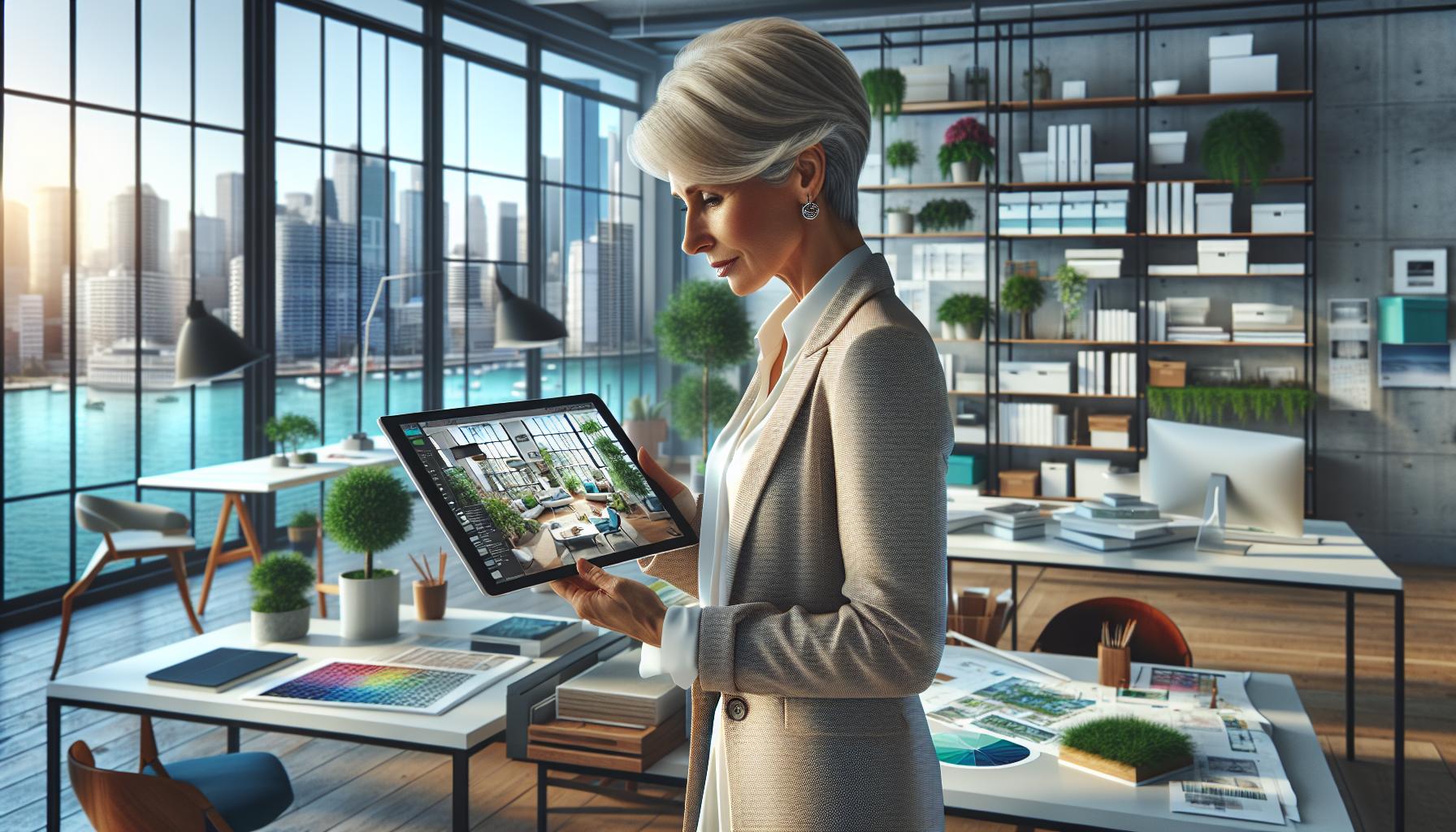 In the world of interior design, the role of an interior design director is pivotal. They blend creativity with strategic thinking, transforming spaces into functional and aesthetically pleasing environments. From residential homes to corporate offices, these professionals oversee every aspect of a project, ensuring that the vision aligns with client needs and industry trends.
In the world of interior design, the role of an interior design director is pivotal. They blend creativity with strategic thinking, transforming spaces into functional and aesthetically pleasing environments. From residential homes to corporate offices, these professionals oversee every aspect of a project, ensuring that the vision aligns with client needs and industry trends.
With a keen eye for detail and a strong understanding of design principles, an interior design director leads a team of designers and architects. They navigate challenges, manage budgets, and maintain timelines, all while fostering collaboration. Their expertise not only enhances the visual appeal of a space but also elevates the overall user experience, making their role essential in today’s design landscape.
Key Takeaways
- Role Overview: Interior design directors are essential in transforming spaces, balancing creativity with strategic project management to deliver functional and attractive environments.
- Key Responsibilities: They lead design teams, manage budgets, coordinate timelines, consult with clients, and stay updated on industry trends to ensure project success.
- Leadership and Collaboration: Effective leadership is crucial as they motivate teams, enhance creativity, and cultivate a collaborative work environment for innovative design solutions.
- Career Path: Aspiring interior design directors require a relevant bachelor’s degree, significant professional experience, and may benefit from advanced education and certifications to enhance their expertise.
- Emerging Trends: The role increasingly incorporates technological advancements like BIM and sustainability practices, reflecting an evolving design landscape that prioritizes innovation and environmental responsibility.
Interior Design Director
An interior design director plays a vital part in creating functional and visually appealing spaces. This role combines leadership, creativity, and strategic planning to effectively manage design projects.
Key Responsibilities
- Leading Design Teams: An interior design director oversees design teams, guiding them in developing innovative concepts that meet client expectations.
- Managing Budgets: This role involves creating and monitoring budgets, ensuring projects remain financially viable while delivering high-quality outcomes.
- Coordinating Timelines: An interior design director establishes project timelines, coordinating various phases to maintain efficiency and ensure timely delivery.
- Client Consultation: Regular consultation with clients occurs to understand their needs, preferences, and feedback, allowing adjustments to design concepts as necessary.
- Staying Current: The director keeps abreast of industry trends and emerging technologies, integrating relevant advancements into design practices.
- Collaborating with Contractors: Coordination with contractors and vendors happens to ensure seamless execution of design elements during construction or renovation phases.
- Creativity: Strong creative skills enable the director to envision unique design solutions that enhance spatial aesthetics.
- Leadership: Effective leadership motivates team members, fostering a collaborative environment that promotes innovation.
- Communication: Excellent communication skills facilitate clear interactions with clients, team members, and stakeholders.
- Project Management: Proficiency in project management ensures efficient workflow, resource allocation, and timeline adherence.
- Problem-Solving: Strong problem-solving abilities help navigate challenges that arise during the design process, ensuring successful outcomes.
- Technical Knowledge: A comprehensive understanding of design software and architectural principles is essential to translate visions into actionable plans.
Importance of an Interior Design Director

An interior design director plays a pivotal role in the success of design projects. Their expertise significantly influences both the aesthetics and functionality of spaces.
Impact on Projects
The interior design director’s influence shapes the project’s direction and outcome. They establish the overall vision and guide design decisions that align with client needs and trends. Effective budget management protects the financial integrity of the project, while timeline coordination ensures timely completion. Regular assessments facilitate adjustments based on project progress, preventing potential setbacks. This proactive approach guarantees a high-quality final product that resonates with users and meets functional requirements.
Leadership in Design Teams
Leadership is essential for an interior design director, as they head design teams to foster collaboration and creativity. They motivate team members, ensuring each individual’s strengths contribute to the design process. By providing clear direction and facilitating open communication, the director cultivates a productive environment. They also mentor emerging designers, enhancing team skills and knowledge. A cohesive team under strong leadership generates innovative concepts, thereby elevating the overall design quality and project outcomes.
Career Path to Becoming an Interior Design Director

Aspiring interior design directors typically follow a structured career path involving education and professional experience. This journey equips them with the necessary skills and knowledge to excel in this highly creative and managerial role.
Educational Requirements
Most interior design directors hold a bachelor’s degree in interior design, architecture, or a related field. Accredited programs provide foundational knowledge in design principles, color theory, space planning, and materials selection. Some institutions offer master’s degrees for advanced study, enhancing expertise. Additionally, obtaining certification from organizations like the National Council for Interior Design Qualification (NCIDQ) is crucial, confirming proficiency in legal and technical aspects of interior design. Ongoing education through workshops and courses in emerging trends and technologies further strengthens their credentials.
Professional Experience
Hands-on experience is vital in developing the skills necessary for an interior design director role. Many start as junior designers, working under the guidance of established professionals. This entry-level experience typically spans three to five years, allowing individuals to refine their design skills, project management abilities, and client interaction techniques. Progressing to mid-level positions, such as project manager or design manager, allows for broader responsibility and team leadership. Accumulating around five to seven years of professional experience in various design settings prepares them for the demands of directing larger projects and leading teams effectively. A strong portfolio showcasing their work enhances their marketability and demonstrates their design capabilities to prospective employers.
Trends Shaping the Role of Interior Design Director

The role of an interior design director is evolving, influenced by several key trends. These trends include technological advancements and sustainability practices, both of which redefine how design professionals approach their work.
Technological Advancements
Technological advancements significantly impact the responsibilities of interior design directors. Tools like Building Information Modeling (BIM) enhance design accuracy and collaboration. Virtual reality (VR) provides immersive experiences, allowing clients to visualize designs before implementation. Directors increasingly utilize design software for streamlined project management and real-time updates. Emerging technologies like augmented reality (AR) facilitate presentations, delivering engaging experiences for clients. The integration of smart home technologies creates demand for designs that incorporate connectivity and automation, necessitating that directors stay updated on these innovations to stay competitive.
Sustainability Practices
Sustainability practices are now a fundamental focus for interior design directors. Implementing eco-friendly materials reduces environmental impact and appeals to clients prioritizing sustainability. Directors explore biophilic design principles that enhance well-being by connecting occupants to nature. Energy-efficient lighting and HVAC systems are among the solutions directors promote for reducing utility costs and improving indoor air quality. Adhering to sustainable practices not only meets client demand but also positions directors as leaders in a market increasingly valuing environmental responsibility and health-conscious design.
Overview of the Role
The role of an interior design director is pivotal in shaping spaces that are not only aesthetically pleasing but also functional. By blending creativity with strategic management they ensure projects meet client expectations while adhering to industry standards. Their leadership fosters collaboration and innovation within design teams leading to superior project outcomes.
As the industry evolves with technological advancements and a growing emphasis on sustainability interior design directors must remain adaptable. Continuous learning and skill enhancement are essential for success in this dynamic field. Ultimately their expertise not only transforms environments but also enriches the overall experience for users making them indispensable in the world of interior design.